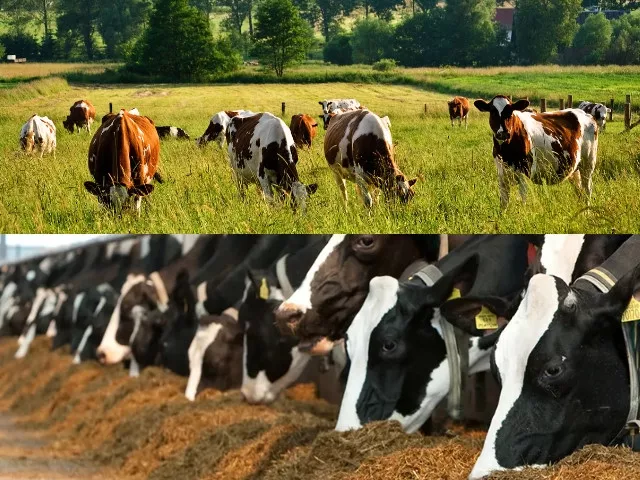Which of the two tastes better and is better for your health?
Grass-Fed or Grain-Fed: What You Need to Know
When we talk about ‘grass-fed’ or ‘grain-fed’ beef, it's crucial to understand what these terms really mean.
Generally, cows consume a diet primarily composed of grass and hay. Even for those labelled as grain-fed, only about 10% of their overall diet consists of grains throughout their lifetime, while the remaining 90% is grass. During the warmer months, cows graze on pasture, and in the colder months, they consume hay, which is essentially dried grass.
Cows categorised as grass-fed eat solely pasture and hay their entire lives. On the other hand, grain-fed cows consume a mix of grass and grains, often introduced to their diet towards the end of their life to enhance fattening before slaughter.
It’s important to note that these labels only refer to their diet and not their living conditions. They don't indicate whether a cow was kept in a pen with exclusive access to grass or hay, nor do they reveal if the cow was raised under organic or naturally grown standards. Neither do they disclose whether the cow received antibiotics or growth hormones, which might be a concern for some consumers. So, take these terms with a grain of salt.
Nutritional Comparison: Grass-Fed vs. Grain-Fed Beef
Based on data from the unbiased source, National Beef Checkoff, here are the nutritional statistics comparing grass-fed beef to grain-fed beef.
| Grass-Fed Beef | Grain-Fed Beef |
| Protein: 21.8 g | 22g |
| Zinc: 3.7mg | 3.8mg |
| Iron: 1.8mg | 1.6mg |
| Total fat: 2.9g | 5.2g |
Both types of beef are nutrient-dense, offering significant amounts of vitamin B12, B3, and B6, as well as highly bioavailable iron, selenium, and zinc. Beef also provides high-quality protein and lesser-known nutrients like creatine and carnosine, which are essential for muscle and brain health.
While the differences are not substantial, grass-fed beef generally has higher levels of certain nutrients. Specifically, it contains more vitamin Precursors such as beta carotene, and higher amounts of vitamin E, an antioxidant that protects cell membranes from oxidation. Additionally, grass-fed beef is richer in other antioxidants compared to grain-fed beef.
Grass-fed beef is leaner and tougher while grain-fed is juicer and a tender cut of meat.
In summary, both grain-fed and grass-fed beef are highly nutritious, but grass-fed beef offers additional benefits with higher carotenoid, vitamin E, and antioxidant content.
Variations in Fatty Acid Content
A cow's diet has a notable impact on the nutritional makeup of its beef, particularly in terms of fatty acid content.
Grass-fed beef tends to have less total fat compared to grain-fed beef, meaning it also has fewer calories per gram. However, the types of fatty acids present differ significantly between the two.
Monounsaturated Fat (Good for heart health, lowers bad cholesterol): Grass-fed beef has significantly less monounsaturated fat than its grain-fed counterpart.
Omega-6 Polyunsaturated Fats (Essential for body functions, but balance with omega-3s is crucial): Both grass-fed and grain-fed beef have similar levels of omega-6 fatty acids.
Omega-3 Fatty Acids (Support heart and brain health, reduce inflammation): This is a key area of difference. Grass-fed beef can contain up to five times more omega-3s than grain-fed beef.
Conjugated Linoleic Acid (CLA) ( May help reduce body fat and improve metabolic health): Grass-fed beef has about twice the amount of CLA compared to grain-fed beef. CLA is linked to several health benefits.
In essence, the type and amount of fat in grass-fed and grain-fed beef vary considerably. Additionally, factors like the breed of the cow and the cut of meat also influence the fat composition.
SUMMARY: Grass-fed beef often has lower total fat content compared to grain-fed beef but boasts significantly higher levels of omega-3 fatty acids and CLA, both of which are associated with various health benefits.
The Takeaway
Despite numerous debates in nutrition, there's a broad consensus that consuming whole, natural foods is crucial. Some people extend this principle by choosing to eat animals that have been fed a natural diet, like cows eating grass and herbs instead of corn and soy.
Ultimately, the decision boils down to your personal preferences and values.









COMMENTS
Comments are moderated and generally will be posted if they are on-topic and not abusive.
For more information, please see our Comments FAQ